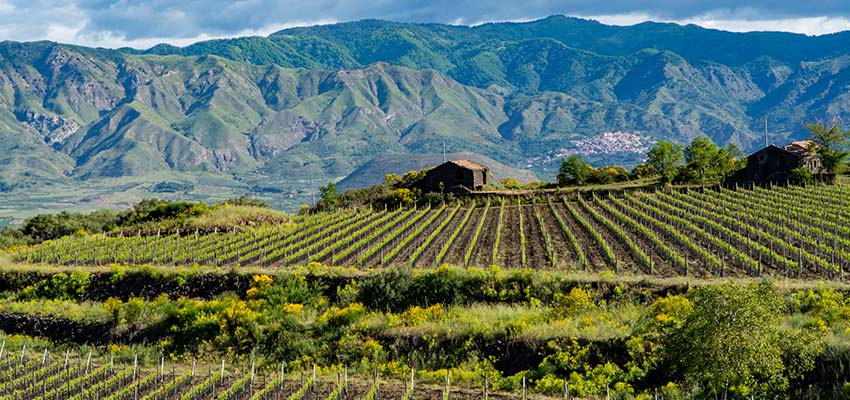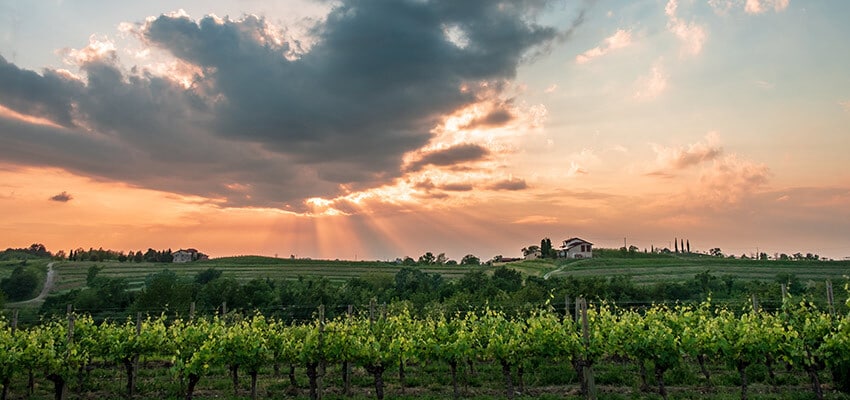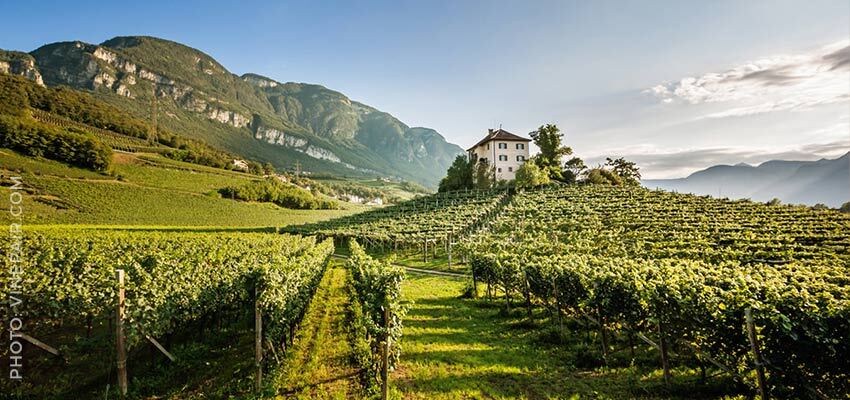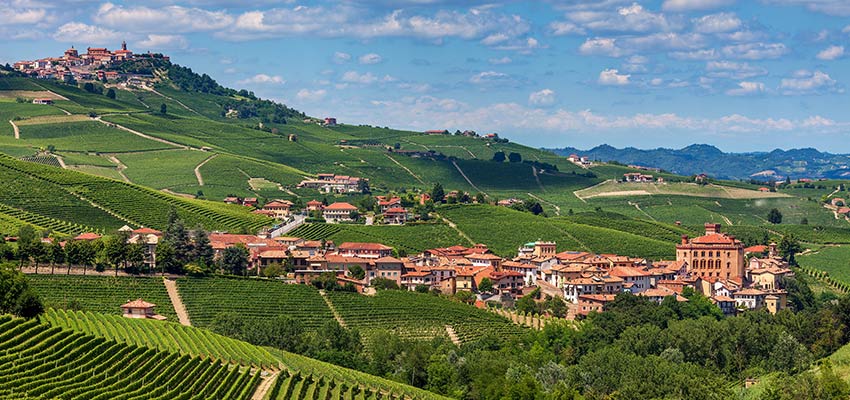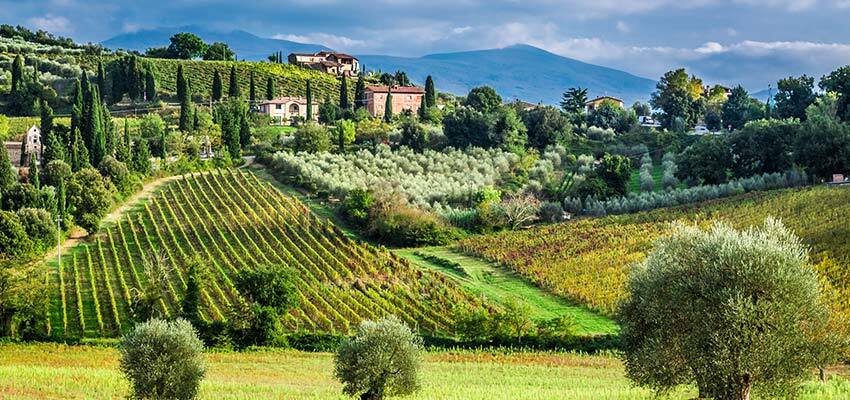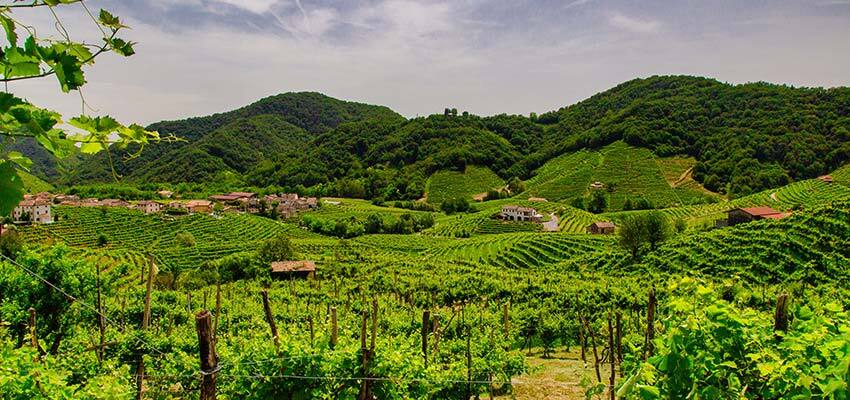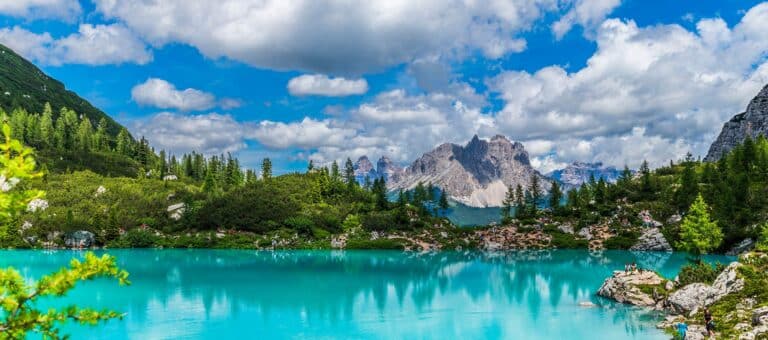The diversity of Italy’s landscape and changing climates has created a haven for wine lovers. It’s also ideal for people who love nature, rolling hills, and lush farmlands. There are thousands of wine grape varietals in Italy, with 350 that are the most commonly used. Tuscany and Piedmont are particularly fine—they’ve been creating wine for hundreds of years. Of course, in regions where wine is grown, local cuisine is fresh and exceptional. Other than high in the Alps, anywhere you visit in Italy is wine country.
Sicily
Taste here: Try a red wine called Nero d’Avola.
Red wines from Sicily are dark and rich because of the warm climate.
WHILE IN SICILY: Sicily is the home of art treasures, natural beauty, and unparalleled wine and cuisine. It’s a complex region with Greek architecture, the wow of Byzantine grandeur, and Arab mosaics. The landscape is a wonder of bucolic farms, volcanoes, and a coastline that hugs turquoise waters. See 5th century Doric temple ruins, dancing gymnasts on mosaic floors, and dazzling coastal sunsets.
Marche
Taste here: Refreshing, aromatic Verdicchio white wines.
Verdicchio is the most common wine in Marche (MAR-kay), Pecorino is an exceptional find, and Lacrima is an ancient, indigenous grape that makes a dry, red wine somewhat like Syrah. This area gave birth to America’s well-known wine dynasty, Mondavi.
WHILE IN MARCHE: Influenced by the Adriatic Sea and two rivers, this area is little-known and worth a visit. Walk the white, sandy beaches with towering cliffs and clear, blue waters. Explore Frasassi Caves, the wildlife in Monte Conero, and a Late Gothic site of pilgrimage.
Friuli-Venezia Giulia
Taste here: White wines, particularly Sauvignon and Pinot Grigio.
Fruili is known for several intense styles of Pinot Grigio and full-bodied Sauvignon Blanc. The region also produces some savory Merlot.
WHILE IN FRIULI-VENEZIA GIULIA: Visit Alps in the north, lagoons along the shore, and an enchanting capital. World-class wines and a culinary heritage bend your expectations. Imagine the literary history in Italy’s most multi-cultural city, Trieste. Discover the 4th century mosaic floors of Basilica di Santa Maria Assunta, tour Europe’s only mosaic school, and go castle-hopping on a pine-dotted coastline.
Trentino Alto-Adige
Taste here: White wines and sparkling wines.
This region is next to the Alps and makes fabulous white wines from Pinot Grigio, Pinot Bianco, Gewürztraminer, and Müller-Thurgau. In Trento, they also produce sparkling wine made with Pinot Noir and Chardonnay that rivals Champagne. The region also produces two unusual red wines, including deep Lagrein, grown in sunny alpine vineyards.
WHILE IN TRENTINO ALTO-ADIGE: Enjoy stunning landscapes. (Some residents speak German or the ancient language, Ladin.) Visitors who appreciate multi-cultural foods will enjoy Austrian dumplings and beet-filled pasta with poppy seeds. Ride high pastures on a horse or mountain bike, luxuriate in a spa beneath snowy peaks and palm trees, and drive the Sudtiroler Weinstrasse—a gourmet route for food and wine tasting.
Piedmont
Taste here: Red wines and Moscato d’Asti.
Piedmont is a good region to gain a deep understanding of Italian wines. You’ll be introduced to a new set of wine grapes from Nebbiolo to Cortese. This region includes Milan and Turin, and is home to one-third of Italy’s population. Besides just the great Nebbiolo wines of Barolo, the region is home to Moscato d’Asti and the varietal, Dolcetto. The cold Alps and warm Mediterranean meet here, and their interaction produces good wine throughout.
WHILE IN PIEDMONT: Piedmont is Italy’s second-largest, and most elegant, region. Slow Food and fine wine are standard. Small towns that once fought over turf now exchange recipes and vintages. Explore Cinque Terre and the coastline by sea, setting sail from La Spezia. Take a street food tour, hunt for truffles and go Barolo wine tasting, or walk ancient streets with a storyteller.
Tuscany
Taste here: Local red wines and a sweet wine called Vin Santo.
Tuscany is home to the Chianti region which is famous for Sangiovese, scarce outside of Italy. Sangiovese became the required major grape in Chianti during the 1970’s. During that time, the combination of Cabernet and Merlot created a new style of wine—Super Tuscan. If you prefer white wine, Trebbiano is Italy’s most produced white grape. Each year approximately 73 million gallons of wine are produced in Tuscany.
WHILE IN TUSCANY: Explore graceful Florence and its exquisite Renaissance art. Set sail to the Mediterranean Isola d’Elba for an olive estate scented with orange groves. Discover Etruscan heritage, and fall under the spell of Gregorian chants sung in a Romanesque abbey, originally founded by Charlemagne in 781 AD.
Veneto
Taste here: Reds and a rich white wine called Soave.
Besides the fabulous red blends of Valpolicella made with Corvina, Rondinella, and Molinara, there are also fine Merlots in the region. For white wines, Garganega is the white grape that makes Soave—it’s a rich white similar to Chardonnay. Vineyards climb up the hillsides and produce Prosecco, which was enjoyed during Roman times and shipped to Egypt’s queen.
WHILE IN VENETO: Take a tasting tour along La Strada del Prosecco. Visit the Bisol family vineyard—since 1524, 21 generations of their family have made some of the best Prosecco in the world. Consider a private day trip to the Dolomites, a boat trip on Lake Garda, and, of course, there is Venice in all her glory.
Wine is part of Italy’s distinctive landscape, culture, tradition, and history. Any trip to Italy will see you dining near vineyards and enjoying life to the fullest. La dolce vita!
For your Italy vacation, let your Destination Expert know what kind of wine and landscapes you most love.


